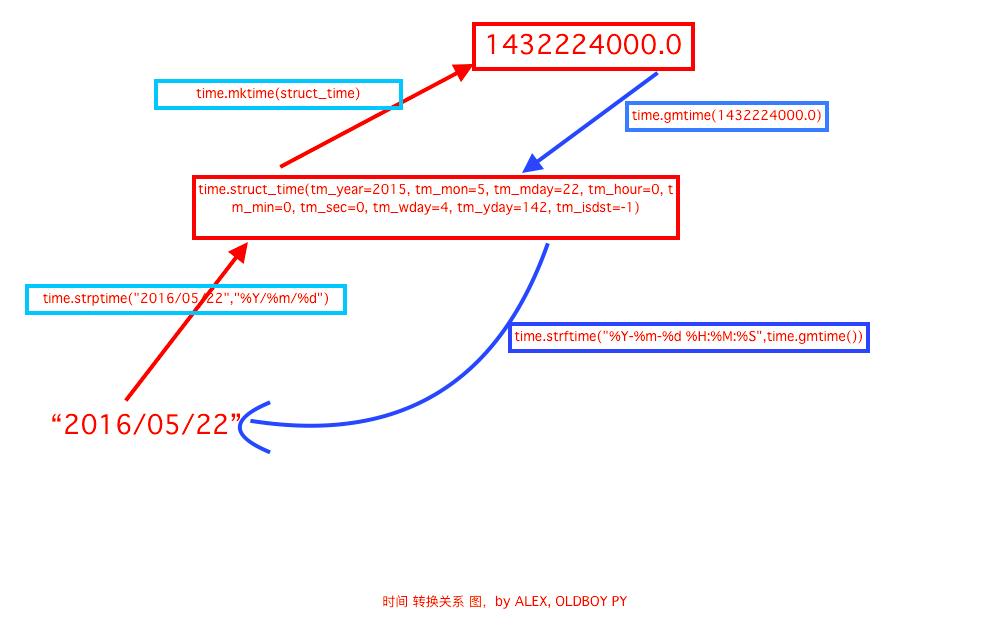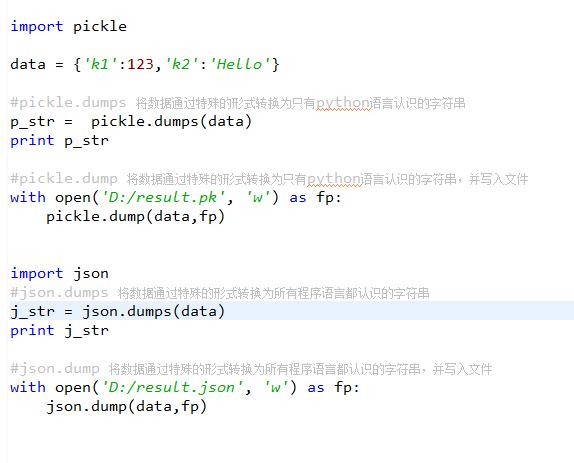常用模块学习
Posted 李栋94
tags:
篇首语:本文由小常识网(cha138.com)小编为大家整理,主要介绍了常用模块学习相关的知识,希望对你有一定的参考价值。
- 模块介绍
- time &datetime模块
- random
- os
- sys
- shutil
- json & picle
- shelve
- xml处理
- yaml处理
- configparser
- hashlib
- subprocess
- logging模块
- re正则表达式
模块,用一砣代码实现了某个功能的代码集合。
类似于函数式编程和面向过程编程,函数式编程则完成一个功能,其他代码用来调用即可,提供了代码的重用性和代码间的耦合。而对于一个复杂的功能来,可能需要多个函数才能完成(函数又可以在不同的.py文件中),n个 .py 文件组成的代码集合就称为模块。
如:os 是系统相关的模块;file是文件操作相关的模块
模块分为三种:
- 自定义模块
- 内置标准模块(又称标准库)
- 开源模块
自定义模块 和开源模块的使用参考 http://www.cnblogs.com/wupeiqi/articles/4963027.html
time & datetime模块
 View Code
View Code
| Directive | Meaning | Notes |
|---|---|---|
%a |
Locale’s abbreviated weekday name. | |
%A |
Locale’s full weekday name. | |
%b |
Locale’s abbreviated month name. | |
%B |
Locale’s full month name. | |
%c |
Locale’s appropriate date and time representation. | |
%d |
Day of the month as a decimal number [01,31]. | |
%H |
Hour (24-hour clock) as a decimal number [00,23]. | |
%I |
Hour (12-hour clock) as a decimal number [01,12]. | |
%j |
Day of the year as a decimal number [001,366]. | |
%m |
Month as a decimal number [01,12]. | |
%M |
Minute as a decimal number [00,59]. | |
%p |
Locale’s equivalent of either AM or PM. | (1) |
%S |
Second as a decimal number [00,61]. | (2) |
%U |
Week number of the year (Sunday as the first day of the week) as a decimal number [00,53]. All days in a new year preceding the first Sunday are considered to be in week 0. | (3) |
%w |
Weekday as a decimal number [0(Sunday),6]. | |
%W |
Week number of the year (Monday as the first day of the week) as a decimal number [00,53]. All days in a new year preceding the first Monday are considered to be in week 0. | (3) |
%x |
Locale’s appropriate date representation. | |
%X |
Locale’s appropriate time representation. | |
%y |
Year without century as a decimal number [00,99]. | |
%Y |
Year with century as a decimal number. | |
%z |
Time zone offset indicating a positive or negative time difference from UTC/GMT of the form +HHMM or -HHMM, where H represents decimal hour digits and M represents decimal minute digits [-23:59, +23:59]. | |
%Z |
Time zone name (no characters if no time zone exists). | |
%% |
A literal \'%\' character. |

random模块
随机数
|
1
2
3
4
|
mport randomprint random.random()print random.randint(1,2)print random.randrange(1,10) |
生成随机验证码
|
1
2
3
4
5
6
7
8
9
10
|
import randomcheckcode = \'\'for i in range(4): current = random.randrange(0,4) if current != i: temp = chr(random.randint(65,90)) else: temp = random.randint(0,9) checkcode += str(temp)print checkcode |
OS模块
提供对操作系统进行调用的接口
|
1
2
3
4
5
6
7
8
9
10
11
12
13
14
15
16
17
18
19
20
21
22
23
24
25
26
27
28
29
|
os.getcwd() 获取当前工作目录,即当前python脚本工作的目录路径os.chdir("dirname") 改变当前脚本工作目录;相当于shell下cdos.curdir 返回当前目录: (\'.\')os.pardir 获取当前目录的父目录字符串名:(\'..\')os.makedirs(\'dirname1/dirname2\') 可生成多层递归目录os.removedirs(\'dirname1\') 若目录为空,则删除,并递归到上一级目录,如若也为空,则删除,依此类推os.mkdir(\'dirname\') 生成单级目录;相当于shell中mkdir dirnameos.rmdir(\'dirname\') 删除单级空目录,若目录不为空则无法删除,报错;相当于shell中rmdir dirnameos.listdir(\'dirname\') 列出指定目录下的所有文件和子目录,包括隐藏文件,并以列表方式打印os.remove() 删除一个文件os.rename("oldname","newname") 重命名文件/目录os.stat(\'path/filename\') 获取文件/目录信息os.sep 输出操作系统特定的路径分隔符,win下为"\\\\",Linux下为"/"os.linesep 输出当前平台使用的行终止符,win下为"\\t\\n",Linux下为"\\n"os.pathsep 输出用于分割文件路径的字符串os.name 输出字符串指示当前使用平台。win->\'nt\'; Linux->\'posix\'os.system("bash command") 运行shell命令,直接显示os.environ 获取系统环境变量os.path.abspath(path) 返回path规范化的绝对路径os.path.split(path) 将path分割成目录和文件名二元组返回os.path.dirname(path) 返回path的目录。其实就是os.path.split(path)的第一个元素os.path.basename(path) 返回path最后的文件名。如何path以/或\\结尾,那么就会返回空值。即os.path.split(path)的第二个元素os.path.exists(path) 如果path存在,返回True;如果path不存在,返回Falseos.path.isabs(path) 如果path是绝对路径,返回Trueos.path.isfile(path) 如果path是一个存在的文件,返回True。否则返回Falseos.path.isdir(path) 如果path是一个存在的目录,则返回True。否则返回Falseos.path.join(path1[, path2[, ...]]) 将多个路径组合后返回,第一个绝对路径之前的参数将被忽略os.path.getatime(path) 返回path所指向的文件或者目录的最后存取时间os.path.getmtime(path) 返回path所指向的文件或者目录的最后修改时间 |
更多猛击这里
sys模块
|
1
2
3
4
5
6
7
8
|
sys.argv 命令行参数List,第一个元素是程序本身路径sys.exit(n) 退出程序,正常退出时exit(0)sys.version 获取Python解释程序的版本信息sys.maxint 最大的Int值sys.path 返回模块的搜索路径,初始化时使用PYTHONPATH环境变量的值sys.platform 返回操作系统平台名称sys.stdout.write(\'please:\')val = sys.stdin.readline()[:-1] |
shutil 模块
直接参考 http://www.cnblogs.com/wupeiqi/articles/4963027.html
json & pickle 模块
用于序列化的两个模块
- json,用于字符串 和 python数据类型间进行转换
- pickle,用于python特有的类型 和 python的数据类型间进行转换
Json模块提供了四个功能:dumps、dump、loads、load
pickle模块提供了四个功能:dumps、dump、loads、load

shelve 模块
shelve模块是一个简单的k,v将内存数据通过文件持久化的模块,可以持久化任何pickle可支持的python数据格式
|
1
2
3
4
5
6
7
8
9
10
11
12
13
14
15
16
17
18
|
import shelved = shelve.open(\'shelve_test\') #打开一个文件class Test(object): def __init__(self,n): self.n = nt = Test(123) t2 = Test(123334)name = ["alex","rain","test"]d["test"] = name #持久化列表d["t1"] = t #持久化类d["t2"] = t2d.close() |
xml处理模块
xml是实现不同语言或程序之间进行数据交换的协议,跟json差不多,但json使用起来更简单,不过,古时候,在json还没诞生的黑暗年代,大家只能选择用xml呀,至今很多传统公司如金融行业的很多系统的接口还主要是xml。
xml的格式如下,就是通过<>节点来区别数据结构的:
xml协议在各个语言里的都 是支持的,在python中可以用以下模块操作xml
|
1
2
3
4
5
6
7
8
9
10
11
12
13
14
15
|
import xml.etree.ElementTree as ETtree = ET.parse("xmltest.xml")root = tree.getroot()print(root.tag)#遍历xml文档for child in root: print(child.tag, child.attrib) for i in child: print(i.tag,i.text)#只遍历year 节点for node in root.iter(\'year\'): print(node.tag,node.text) |
修改和删除xml文档内容
自己创建xml文档
|
1
2
3
4
5
6
7
8
9
10
11
12
13
14
15
16
|
import xml.etree.ElementTree as ETnew_xml = ET.Element("namelist")name = ET.SubElement(new_xml,"name",attrib={"enrolled":"yes"})age = ET.SubElement(name,"age",attrib={"checked":"no"})sex = ET.SubElement(name,"sex")sex.text = \'33\'name2 = ET.SubElement(new_xml,"name",attrib={"enrolled":"no"})age = ET.SubElement(name2,"age")age.text = \'19\'et = ET.ElementTree(new_xml) #生成文档对象et.write("test.xml", encoding="utf-8",xml_declaration=True)ET.dump(new_xml) #打印生成的格式 |
PyYAML模块
Python也可以很容易的处理ymal文档格式,只不过需要安装一个模块,参考文档:http://pyyaml.org/wiki/PyYAMLDocumentation
ConfigParser模块
用于生成和修改常见配置文档,当前模块的名称在 python 3.x 版本中变更为 configparser。
来看一个好多软件的常见文档格式如下
|
1
2
3
4
5
6
7
8
9
10
11
12
|
[DEFAULT]ServerAliveInterval = 45Compression = yesCompressionLevel = 9ForwardX11 = yes[bitbucket.org]User = hg[topsecret.server.com]Port = 50022ForwardX11 = no |
如果想用python生成一个这样的文档怎么做呢?
|
1
2
3
4
5
6
7
8
9
10
11
12
13
14
15
16
|
import configparserconfig = configparser.ConfigParser()config["DEFAULT"] = {\'ServerAliveInterval\': \'45\', \'Compression\': \'yes\', \'CompressionLevel\': \'9\'}config[\'bitbucket.org\'] = {}config[\'bitbucket.org\'][\'User\'] = \'hg\'config[\'topsecret.server.com\'] = {}topsecret = config[\'topsecret.server.com\']topsecret[\'Host Port\'] = \'50022\' # mutates the parsertopsecret[\'ForwardX11\'] = \'no\' # same hereconfig[\'DEFAULT\'][\'ForwardX11\'] = \'yes\'with open(\'example.ini\', \'w\') as configfile: config.write(configfile) |
写完了还可以再读出来哈。
configparser增删改查语法
hashlib模块
用于加密相关的操作,3.x里代替了md5模块和sha模块,主要提供 SHA1, SHA224, SHA256, SHA384, SHA512 ,MD5 算法
还不够吊?python 还有一个 hmac 模块,它内部对我们创建 key 和 内容 再进行处理然后再加密
散列消息鉴别码,简称HMAC,是一种基于消息鉴别码MAC(Message Authentication Code)的鉴别机制。使用HMAC时,消息通讯的双方,通过验证消息中加入的鉴别密钥K来鉴别消息的真伪;
一般用于网络通信中消息加密,前提是双方先要约定好key,就像接头暗号一样,然后消息发送把用key把消息加密,接收方用key + 消息明文再加密,拿加密后的值 跟 发送者的相对比是否相等,这样就能验证消息的真实性,及发送者的合法性了。
|
1
2
3
|
import hmach = hmac.new(b\'天王盖地虎\', b\'宝塔镇河妖\')print h.hexdigest() |
更多关于md5,sha1,sha256等介绍的文章看这里https://www.tbs-certificates.co.uk/FAQ/en/sha256.html
Subprocess模块
The subprocess module allows you to spawn new processes, connect to their input/output/error pipes, and obtain their return codes. This module intends to replace several older modules and functions:
os.system
os.spawn*
The recommended approach to invoking subprocesses is to use the run() function for all use cases it can handle. For more advanced use cases, the underlying Popen interface can be used directly.
The run() function was added in Python 3.5; if you need to retain compatibility with older versions, see the Older high-level API section.
subprocess.run(args, *, stdin=None, input=None, stdout=None, stderr=None, shell=False, timeout=None, check=False)Run the command described by args. Wait for command to complete, then return a CompletedProcess instance.
The arguments shown above are merely the most common ones, described below in Frequently Used Arguments (hence the use of keyword-only notation in the abbreviated signature). The full function signature is largely the same as that of the Popen constructor - apart from timeout, input and check, all the arguments to this function are passed through to that interface.
This does not capture stdout or stderr by default. To do so, pass PIPE for the stdout and/or stderr arguments.
The timeout argument is passed to Popen.communicate(). If the timeout expires, the child process will be killed and waited for. The TimeoutExpired exception will be re-raised after the child process has terminated.
The input argument is passed to Popen.communicate() and thus to the subprocess’s stdin. If used it must be a byte sequence, or a string if universal_newlines=True. When used, the internal Popen object is automatically created withstdin=PIPE, and the stdin argument may not be used as well.
If check is True, and the process exits with a non-zero exit code, a CalledProcessError exception will be raised. Attributes of that exception hold the arguments, the exit code, and stdout and stderr if they were captured.
常用subprocess方法示例
#执行命令,返回命令执行状态 , 0 or 非0
>>> retcode = subprocess.call(["ls", "-l"])
#执行命令,如果命令结果为0,就正常返回,否则抛异常
>>> subprocess.check_call(["ls", "-l"])
0
#接收字符串格式命令,返回元组形式,第1个元素是执行状态,第2个是命令结果
>>> subprocess.getstatusoutput(\'ls /bin/ls\')
(0, \'/bin/ls\')
#接收字符串格式命令,并返回结果
>>> subprocess.getoutput(\'ls /bin/ls\')
\'/bin/ls\'
#执行命令,并返回结果,注意是返回结果,不是打印,下例结果返回给res
>>> res=subprocess.check_output([\'ls\',\'-l\'])
>>> res
b\'total 0\\ndrwxr-xr-x 12 alex staff 408 Nov 2 11:05 OldBoyCRM\\n\'
#上面那些方法,底层都是封装的subprocess.Popen
poll()
Check if child process has terminated. Returns returncode
wait()
Wait for child process to terminate. Returns returncode attribute.
terminate() 杀掉所启动进程
communicate() 等待任务结束
stdin 标准输入
stdout 标准输出
stderr 标准错误
pid
The process ID of the child process.
#例子
>>> p = subprocess.Popen("df -h|grep disk",stdin=subprocess.PIPE,stdout=subprocess.PIPE,shell=True)
>>> p.stdout.read()
b\'/dev/disk1 465Gi 64Gi 400Gi 14% 16901472 104938142 14% /\\n\'
|
1
2
3
4
5
6
7
8
9
10
11
|
>>> subprocess.run(["ls", "-l"]) # doesn\'t capture outputCompletedProcess(args=[\'ls\', \'-l\'], returncode=0)>>> subprocess.run("exit 1", shell=True, check=True)Traceback (most recent call last): ...subprocess.CalledProcessError: Command \'exit 1\' returned non-zero exit status 1>>> subprocess.run(["ls", "-l", "/dev/null"], stdout=subprocess.PIPE)CompletedProcess(args=[\'ls\', \'-l\', \'/dev/null\'], returncode=0,stdout=b\'crw-rw-rw- 1 root root 1, 3 Jan 23 16:23 /dev/null\\n\') |
调用subprocess.run(...)是推荐的常用方法,在大多数情况下能满足需求,但如果你可能需要进行一些复杂的与系统的交互的话,你还可以用subprocess.Popen(),语法如下:
|
1
2
|
p = subprocess.Popen("find / -size +1000000 -exec ls -shl {} \\;",shell=True,stdout=subprocess.PIPE)print(p.stdout.read()) |
可用参数:
- args:shell命令,可以是字符串或者序列类型(如:list,元组)
- bufsize:指定缓冲。0 无缓冲,1 行缓冲,其他 缓冲区大小,负值 系统缓冲
- stdin, stdout, stderr:分别表示程序的标准输入、输出、错误句柄
- preexec_fn:只在Unix平台下有效,用于指定一个可执行对象(callable object),它将在子进程运行之前被调用
- close_sfs:在windows平台下,如果close_fds被设置为True,则新创建的子进程将不会继承父进程的输入、输出、错误管道。
所以不能将close_fds设置为True同时重定向子进程的标准输入、输出与错误(stdin, stdout, stderr)。 - shell:同上
- cwd:用于设置子进程的当前目录
- env:用于指定子进程的环境变量。如果env = None,子进程的环境变量将从父进程中继承。
- universal_newlines:不同系统的换行符不同,True -> 同意使用 \\n
- startupinfo与createionflags只在windows下有效
将被传递给底层的CreateProcess()函数,用于设置子进程的一些属性,如:主窗口的外观,进程的优先级等等
终端输入的命令分为两种:
- 输入即可得到输出,如:ifconfig
- 输入进行某环境,依赖再输入,如:python
需要交互的命令示例
|
1
2
3
4
5
6
7
8
9
10
|
import subprocessobj = subprocess.Popen(["python"], stdin=subprocess.PIPE, stdout=subprocess.PIPE, stderr=subprocess.PIPE)obj.stdin.write(\'print 1 \\n \')obj.stdin.write(\'print 2 \\n \')obj.stdin.write(\'print 3 \\n \')obj.stdin.write(\'print 4 \\n \') 以上是关于常用模块学习的主要内容,如果未能解决你的问题,请参考以下文章
|